‘Behemoth’ is a word which springs to mind or, perhaps more nautically, ‘leviathan’.

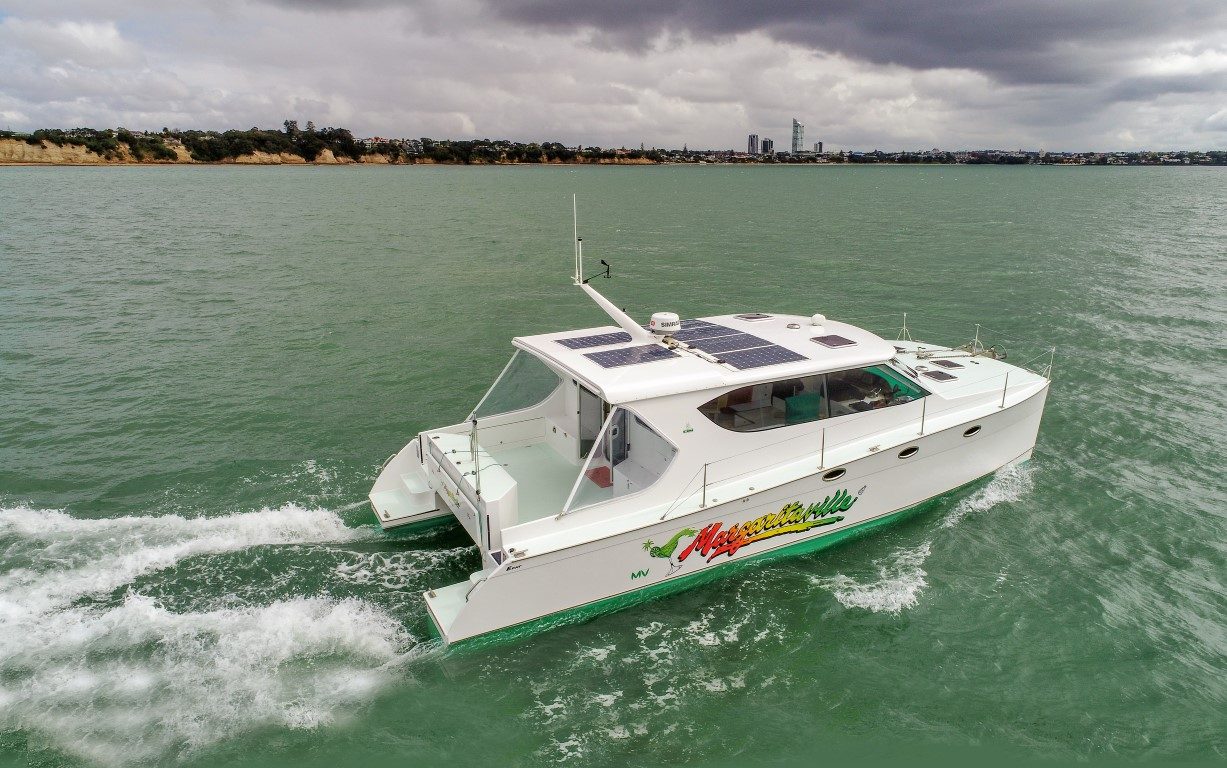
The time comes for all yachties to slip into something more comfortable, and for the Elliotts, it’s Margaritaville, their Ron Given-designed E-Cat 11.5m, built by Craig Partridge Yachts in the Bay of Islands.
Sandra and Garry Elliott have been putting the fun into boating for years, first with their Ross 930 Wasted Away, then with the Ross 1066 Wasted Away Again and now with Margaritaville. As Garry jokes, it took them 20 years to get through one line of the Jimmy Buffett song.
The powercat was built alongside Partridge’s E-cat, Taiaha Rua, which featured in the July 2016 edition of Boating New Zealand. The Elliotts saw Partridge’s own boat under construction and decided they wanted a bit of that – with a few modifications.
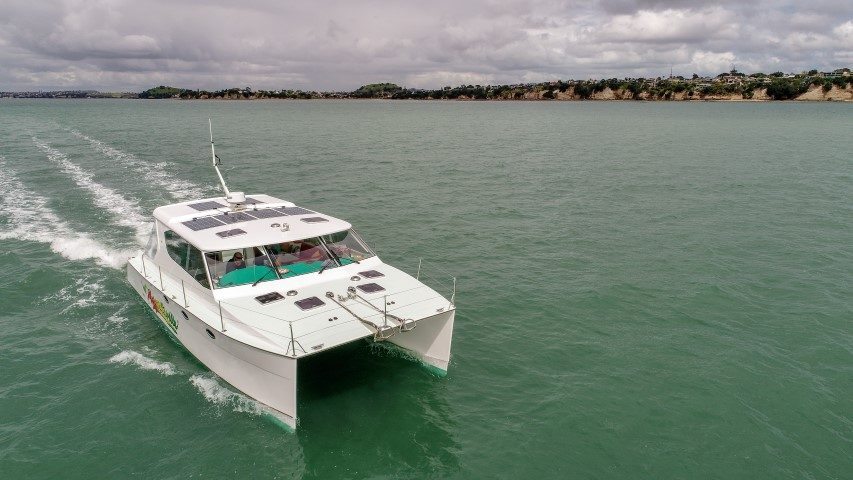
“It was good to see Craig’s boat half-built,” says Garry. “We had been thinking about doing something like this for three or four years, and when he was about four months into building his boat, we started to talk about what we wanted to do. Years of sailing have taught us what we really want in a boat.”
Garry’s been a sailor since the age of 12 but at 77, he says, he’s not getting any younger. Cruising on a yacht was becoming less convenient, and the idea of having more space and fewer ropes started to appeal. “If you’re going up the coast and it really freshens up, you have trouble reefing or getting the main down.”
Margaritaville is similar to Taiaha Rua, with a few modifications. The hulls are from the same moulds but are 750mm longer for more storage space in the saloon and a larger galley. Overall she’s also 250mm narrower, to fit into the Elliotts’ marina berth at Orakei. The boat also has a pullout roof over the cockpit, dubbed the ‘garage door’, and a lift-up platform on the transom for storing the tender.
Partridge and the Elliotts worked together with designer Ron Given to make the tweaks as construction progressed. “Here we were: three yachties designing a launch,” laughs Garry.
PROVEN HULL
It’s obvious this boat is meant for fun. She features large, colourful graphics which will be familiar to anyone who knows the Elliotts’ yachts, complete with cocktail glass and minty-green anti-fouling. The boat has a typical Given look, with high topsides at the bow and curving down towards the stern, and a flat cabin top which holds an array of solar panels. There’s good clearance under the wing deck for a comfortable ride.
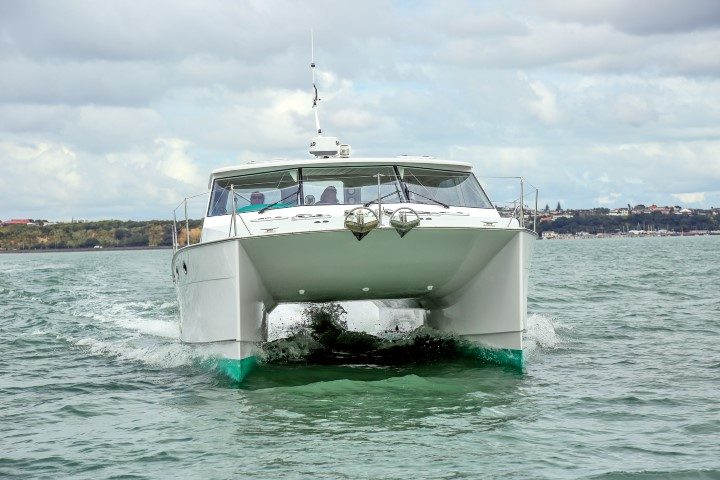
The hull shape, which Given’s used for several years, was designed for fuel efficiency. Construction methods are geared to weight saving – hulls are moulded foam and glass, with the wing deck and cabin top made of vacuum-bagged ply-foam-ply sandwich.
She is powered by a pair of 87hp Lombardini diesels with sail-drives. High speed was not a priority: as sailors the Elliotts have no desire to race around burning up fossil fuels.
“We’ve got a lot of friends with fast planing boats and they are always filling them up. I’m not interested in hurrying – getting there is half the fun,” says Garry. “We can cruise up north at 13 knots, or drop it back to 7 or 8 knots and put a line out and catch some fish along the way. As yachties, we’re used to doing 6 or 7 knots.”
At around 2,600 revs she has a comfortable cruise speed of 14-15 knots – and can make it across to the Coromandel from Auckland in around two and a half hours. At that speed Margaritaville is only using around 1.3 litres of diesel per nautical mile.
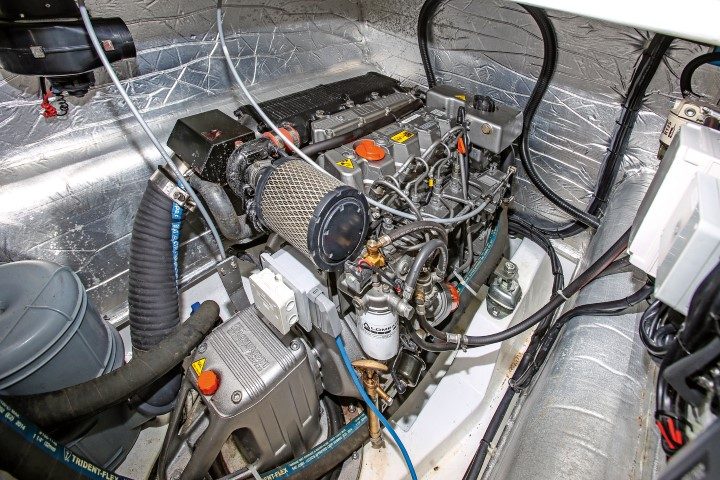
“It used to take us five hours in a yacht – we’re now going further for weekends,” Garry says. Going further afield, the Elliotts can reach their favoured cruising ground in the Whangaroa Harbour, north of the Bay of Islands, in around 10 hours, cruising at an average of 15 knots.
At Whangaroa, the Elliotts meet up with a bunch of other like-minded cruisers under the self-assumed banner of the ‘Royale Whangaroa Yacht Club’, the official charter of which is on proud display in Margaritaville’s saloon. The group of ‘social drinkers with a boating problem’ get together for social events, and everyone is a commodore.
“The camaraderie shared by members is such that ‘rules’ in the normal sense are inappropriate and any sense of formality is for the entertainment that such pomp and ceremony usually provides,” the charter notes.
PARTY BOAT
Entry onboard is via walk-throughs in the transom of both hulls. The tender sits on a ‘shelf’ that folds down between the two hulls, and can be raised and lowered by a removable davit on the wide transom. “It’s easy to put in, easy to launch and retrieve – Garry can do it on his own. It was a two-person job on the yacht,” Sandra notes.
Margaritaville is made for entertaining, starting with the huge cockpit. The Elliotts wanted plenty of seating here, so as well as a fixed seat at the back of the cabin on each side,
extra seating folds out of the sides of the cockpit to complete a u-shape. The boat’s colourful décor starts here, too: bright yellow canvas squabs set a party mood as soon as you step onboard, and the cockpit floor is minty-green non-skid.
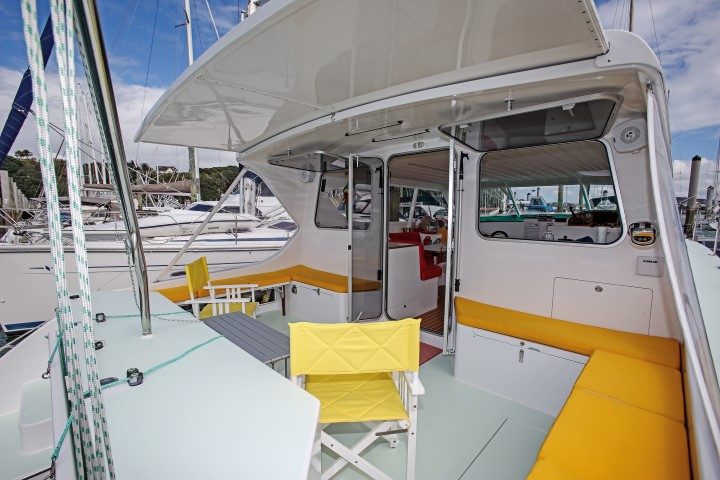
The cockpit area can be completely covered by an extendable hard-top which slides out from the rear of the cabin, creating a shaded, sheltered outdoor room with the addition of custom clears at the sides. At the rear a wide transom creates another seating space and provides room for the barbecue.
The use of colour and sense of fun continues inside. The cabin’s accessed via a pair of central doors, with large, top-hinged windows bringing plenty of light into the saloon. It’s a bright interior – not only because of the light from the wrap-around windows, but also the décor. A colourful, possibly tipsy parrot, hangs in one corner, and bright cushions complement the coral-coloured upholstery. Obviously, this is a boat which is enjoyed and utilised, not a showroom special.
Aspects of Sandra and Garry’s personality are visible everywhere, from their collections of glasses and candles to a handily-positioned tambourine, in case the occasion calls for it. The bright space is given a nautical touch by the practical teaklook vinyl flooring. There’s a u-shaped seating area with a large table to port, with extra seating provided by bright yellow canvas director’s chairs, which do double-duty out in the cockpit too.
The galley is to starboard, just inside the cabin doors. It offers plenty of bench space – especially compared to a yacht’s galley. The tap folds away and a lid comes down over the sink to keep things tidy. Clever storage solutions such as a narrow, pull-out spice rack make the most of the available space. Another example is the emergency locker, containing flares and lifejackets, which is accessed from the cockpit side but tucks into the ‘dead’ corner of the bench inside which would otherwise be hard to access and utilise.
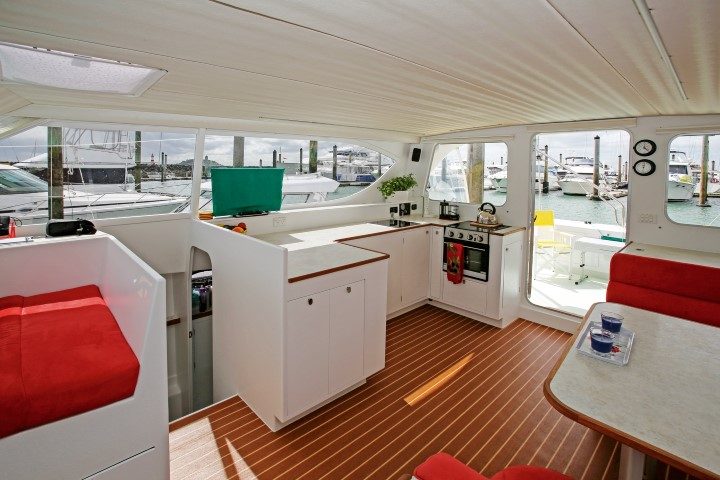
Overhead, LED strip lighting and lighting in the pelmets keeps this area well illuminated at night. “We went a bit overboard, but it’s been worth it,” Sandra says. “On the yacht, when I was working in the galley I was always in a shadow so I wanted decent lighting.”
Plenty of refrigeration space for longer cruises was also a high priority. It’s built into the back of the settee at the rear of the saloon: a top-loading, 160-litre Danfoss unit and a 50-litre freezer.
Forward of the galley is the helm station, with a double helm seat and a handy footrest. Electronics include a Simrad chart plotter, VHF and stereo controls to port, and the CZone electrical control system, which provides a digital switch interface with pre-set ‘zones’ for different lighting and power configurations.
SLEEPING SPACE
Accommodation is down below in the hulls. The Elliotts knew what they wanted for their personal space. “We mostly cruise by ourselves and we know what we like. But when we do have friends aboard, there are two, quite separate sleeping areas, which is really good,” says Garry.
During construction, the central bulkhead between the two cabins was pushed over to port, to make one cabin larger than the other, rather than creating two symmetrical spaces. Now, the starboard cabin is the ‘master’, with a larger bed positioned athwartships, with room to get into bed on each side.
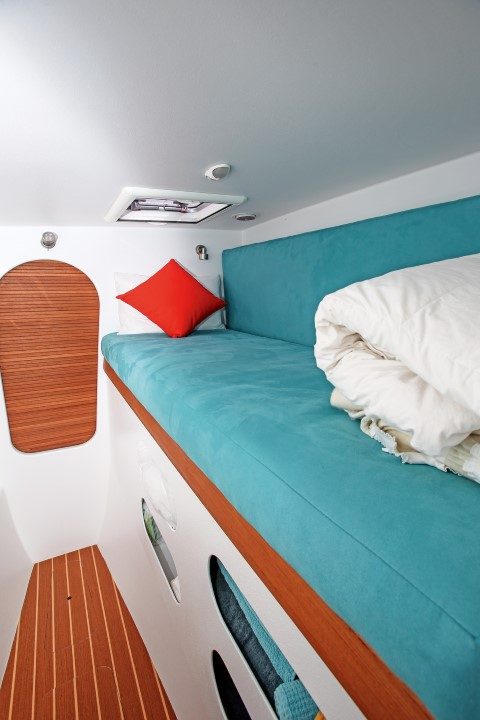
“We’ve been climbing over the other person for too many years. We saw the bulkhead going in between the cabins and asked Craig if we could change it. There was no reason for it to be symmetrical, so he pushed the bulkhead over to the other side.”
The port-side cabin has a more traditional fore-and-aft single which can be extended out to a double, with turquoise upholstery and a large storage locker in the forward bulkhead. A further double can be created by lowering the saloon table.
There is a Lectrasan head and shower on both sides aft of the steps down. On the port side, aft of the head is access to the ‘man cave’, which houses all the electrical services, including the batteries and inverter, and on the starboard side there is access to the water tanks. The boat has six large solar panels on the cabin roof, charging a bank of lithium-ion batteries. “We can have the boat ticking over on the solar panels in the marina, and when you’re away you can start the day with half-full batteries and be fully-charged by lunchtime without moving or turning the engines on. The lithium-ion batteries also weigh about one-third of regular batteries.”
Solar panels bring the luxury of a freezer, which the Elliotts haven’t had before. Of course, this means they can now make ice-cream margaritas.
CRUISING TIME
There is no doubt Margaritaville is going to enjoy plenty of use. While she’s been in the water for nearly two years, the Elliotts have been too busy with work, travel and other commitments to take her out much. However, having the boat moored at Orakei means it’s close to home, and getting out on the water doesn’t take long. Sandra is also enjoying the ease of getting set up for cruising expeditions.

“I don’t miss the hard yards I used to have to go through to take the yacht out of race mode and put it into cruise mode – hauling all the sails off the boat and putting all the squabs back on. Now, I walk on and walk off,” she says.
Not that the Elliotts are walking away from yachting entirely: in 2017 they bought back their much-loved Wasted Away, which has been refurbished by Partridge, ready for more racing. It’s the best of both worlds.
‘Behemoth’ is a word which springs to mind or, perhaps more nautically, ‘leviathan’.
White Pointer has earned the respect of discerning customers in New Zealand and Australia, attracting a loyal and ever growing following for its high-quality, rugged and totally dependable aluminium trailer boats.
The hardtop SP635 shares the same underpinnings as the popular SF 635 which was a completely new model back in 2020.
The pride and joy of a multi-generational family, Bliss resides on a pier that’s home to a couple of other Elite motor launches – Sandspit Marina is a hot-spot for the Bill Upfold-designed vessels, with several calling this small marina home.